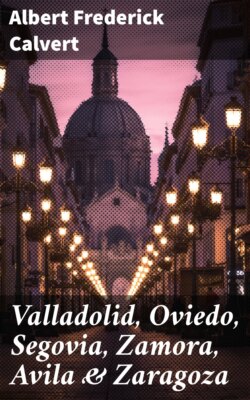Читать книгу Valladolid, Oviedo, Segovia, Zamora, Avila & Zaragoza - Albert Frederick Calvert - Страница 3
На сайте Литреса книга снята с продажи.
ОглавлениеPREFACE
Table of Contents
The six cities of Spain which form the subject of the following pages are little known to English travellers. Yet no one who would understand the country can afford to pass them by. Not only are they compact of artistic and architectural treasures, but within their walls much of the history of the Spanish nation has been made. Oviedo—that little city between the mountains and the sea, so far off the beaten track—was the cradle of the monarchy, the residence and burial-place of its patriot kings. For all men of Spanish blood it is holy ground. In Zamora we have the typical city of the heroic age of Spain, the era of half-fabulous heroes, whose personalities are made known to us only by folklore and ballads.
Segovia and Avila are towns of the Reconquest, wardens, one might say, against the redoubtable Moor. To the fancy their grass-grown streets still re-echo with the tramp of armed men, with the ring of spears and the word of command. The shadowy warriors of Oviedo and Zamora here give place to the tall knight who stalks across the page of history, ready to do battle with pagan Moor or Christian tyrant. But Avila enshrines the holier memory of the sainted Theresa, greatest of Spanish women, revered not least in the lands for whose conversion to her faith she unceasingly prayed. And so we pass on, each town illustrating a different stage of a great nation’s development.
In Valladolid, which preceded and subsequently nearly supplanted Madrid as the capital of Spain, we are again on holy ground; for Cervantes dwelt here, and here died the immortal Columbus. Zaragoza, the chief city of a kingdom that influenced the destinies of powerful European States when Castile was hardly known to the outside world, has ever been a noble and important capital, boasting a glory which has been brightest perhaps in its later days. To the citizens of Zaragoza was reserved the honour of rejecting the Inquisition, to which other towns reluctantly submitted, and just one hundred years ago she proved to an astonished Europe that within her crumbling walls dwelt the old brood of Numantia—that she was prolific still of heroes and heroines.
The prowess of Augustina would not indeed have come as a surprise to those who knew her country well; nor could the most thoughtless of travellers, after a survey of the memorials of genius and vitality which these six cities contain, ever believe the greatness of the people to be exhausted. Already Valladolid and Zaragoza throb with life and commerce. But a few more years and the other cities, already stirring, will pulsate with the spirit of young Spain, and the Phœnix, born a thousand years ago at Oviedo, will renew its youth for the tenth time.
To Señor J. Lacoste my thanks are due for his courtesy in permitting me to reproduce many of the photographs which find a place in this book, and I have also to acknowledge the assistance rendered me by Mr. E. B. d’Auvergne in the preparation of the text.
A. F. C.
ILLUSTRATIONS
Table of Contents
